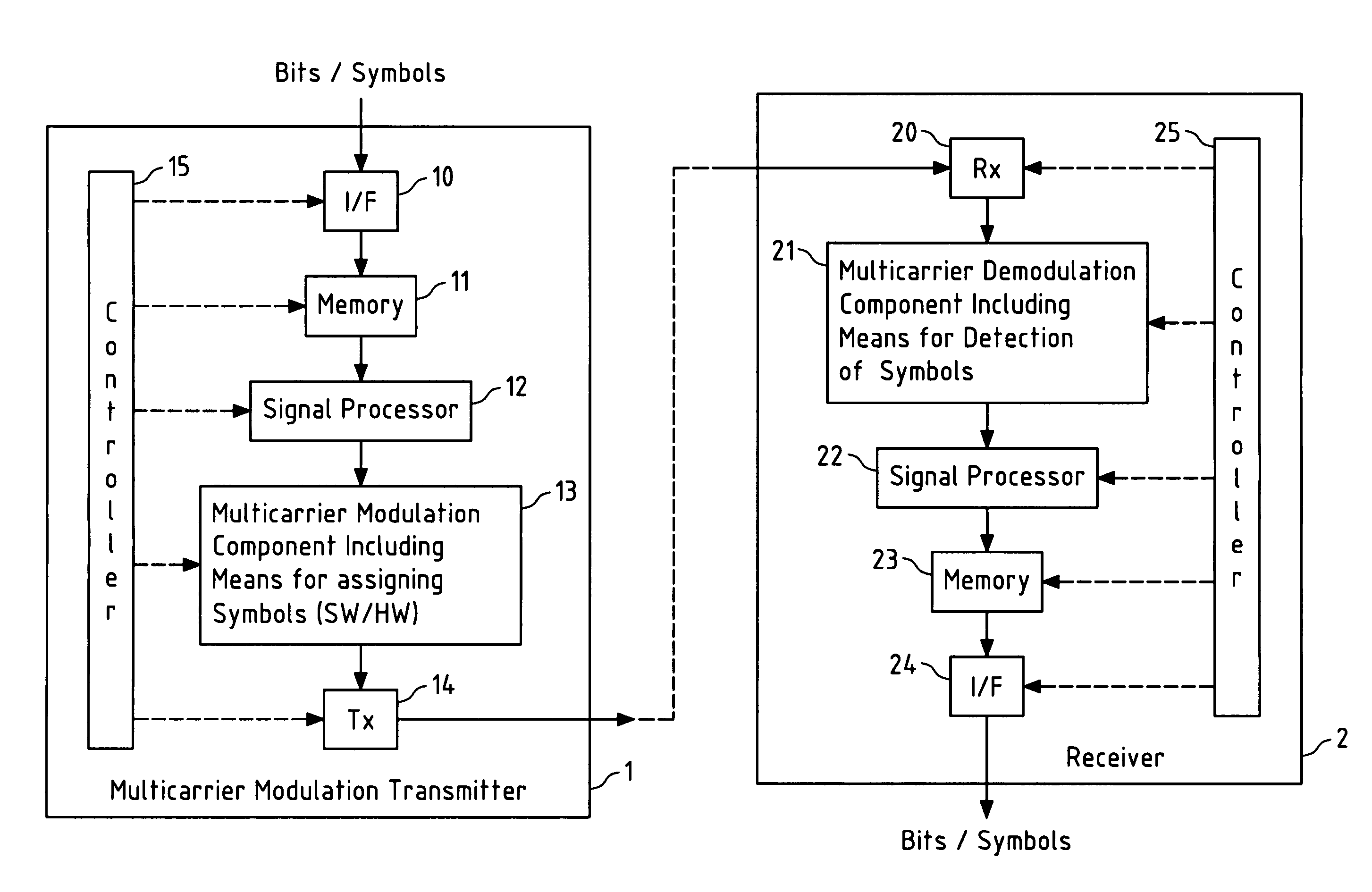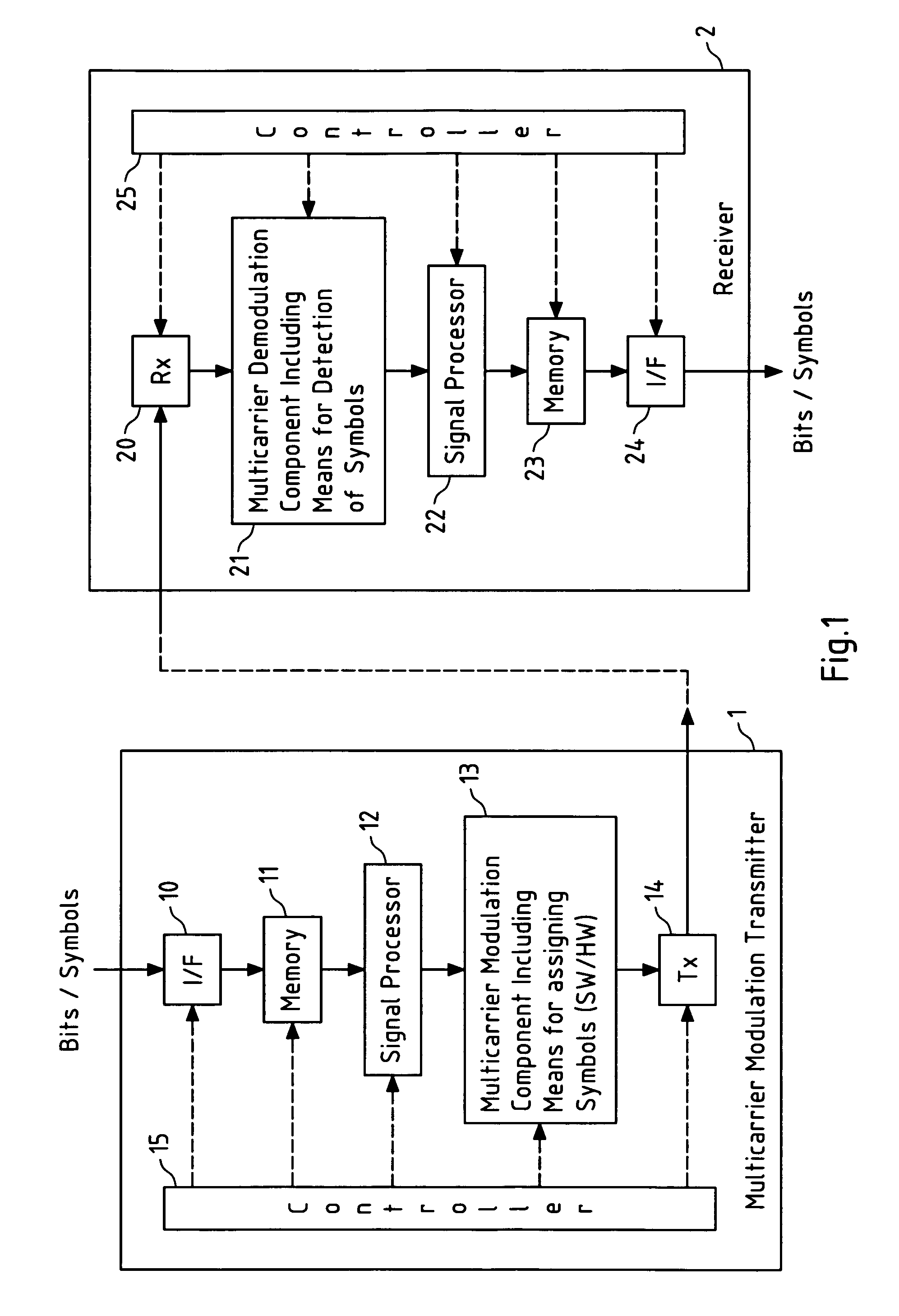Multicarrier modulation with enhanced frequency coding
a multi-carrier, frequency-coding technology, applied in the direction of amplitude demodulation, line-fault/interference reduction, baseband system details, etc., can solve the problems of excessive limitation of transmit power, high complexity, and increased noise level of active uwb system, so as to reduce the transmission power, minimize the transmission power, and mitigate the transmission power
- Summary
- Abstract
- Description
- Claims
- Application Information
AI Technical Summary
Benefits of technology
Problems solved by technology
Method used
Image
Examples
first embodiment
of the Present Invention
[0053]As an example for the application of the present invention, said MB-OFDM modulation for said 53.3 and 80 Mbps operational modes of said WPANs is considered and an embodiment of the present invention is given therefore.
[0054]The implementation of the present example is according to FIG. 2, which depicts a flowchart of a method for mitigation of interference introduced by a multicarrier modulation according to the present invention, and wherein said flowchart describes operational steps of a multicarrier modulation component 13 including means for assigning symbols within a transmitter 1 depicted in FIG. 1.
[0055]In the present example, a stream of 50 QPSK data symbols {c0, . . . , c49} is received for every other OFDM symbol interval. In a step 100, it is checked whether time-domain spreading should be applied or not. As this is not the case in the present example, during the first OFDM symbol interval the subset S1={c0, . . . , c24} of said data symbols ...
second embodiment
of the Present Invention
[0077]As a second example for the application of the present invention, said MB-OFDM modulation for said 53.3 and 80 Mbps operational modes of said WPANs is considered and an embodiment of the present invention is given therefore.
[0078]The implementation of the present example is according to FIG. 1, which depicts a flowchart of a method for mitigation of interference introduced by a multicarrier modulation according to the present invention, and wherein said flowchart describes operational steps of a multicarrier modulation component 13 including means for assigning symbols within a transmitter 1 depicted in FIG. 1.
[0079]In the present example, a stream of 50 QPSK data symbols {c0, . . . , c49} is received for every other OFDM symbol interval. In a step 100, it is checked whether time-domain spreading should be applied or not. During said first OFDM symbol interval, no time-domain spreading is introduced, thus in a step 101 a data block S1={c0, . . . , c49} ...
third embodiment
of the Present Invention
[0090]As a third for the application of the present invention, said MB-OFDM modulation for said 106.7, 160 and 200 Mbps operational modes of said WPANs is considered and an embodiment of the present invention is given therefore.
[0091]The implementation of the present example is according to FIG. 1, which depicts a flowchart of a method for mitigation of interference introduced by a multicarrier modulation according to the present invention, and wherein said flowchart describes operational steps of a multicarrier modulation component 13 including means for assigning symbols within a transmitter 1 depicted in FIG. 1.
[0092]In the present example, a stream of 100 QPSK data symbols {c0, . . . , c99} is received for every other OFDM symbol interval. In a step is checked whether time-domain spreading should be applied or not. As this is not the case in the present example, during the first OFDM symbol interval the subset S1={c0, . . . ,c49} of said data symbols is f...
PUM
 Login to View More
Login to View More Abstract
Description
Claims
Application Information
 Login to View More
Login to View More - R&D
- Intellectual Property
- Life Sciences
- Materials
- Tech Scout
- Unparalleled Data Quality
- Higher Quality Content
- 60% Fewer Hallucinations
Browse by: Latest US Patents, China's latest patents, Technical Efficacy Thesaurus, Application Domain, Technology Topic, Popular Technical Reports.
© 2025 PatSnap. All rights reserved.Legal|Privacy policy|Modern Slavery Act Transparency Statement|Sitemap|About US| Contact US: help@patsnap.com



